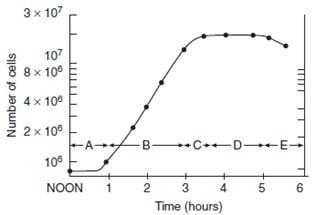USMLE-STEP-1 Online Practice Questions and Answers
Lack of oxygen (hypoxia) will cause reflex vasoconstriction in the circulation supplying which of the following organs?
A. brain
B. heart muscle
C. kidney
D. lungs
E. skeletal muscle
A 37-year-old man was immunologically competent but presented to his physician with malaise, fever, lethargy, and back pain. Examination also revealed vertebral osteomyelitis, splenomegaly, and hepatomegaly. He was a PPD-negative farm worker who consumed unpasteurized goat milk. Which of the organisms listed below is the mostlikely etiological agent?
A. Actinomyces israelii
B. Aspergillus fumigates
C. Brucella melitensis
D. Candida albicans
E. Mycobacterium tuberculosis
After isolating a pathogen from a patient, you monitor its growth in rich medium. According to below figure the rate of growth of the bacterial culture for which it was obtained reaches its maximum rate of growth between which of the following time periods?

A. noon and 1:00 p.m.
B. 2:00 p.m. and 3:00 p.m.
C. 3:00 p.m. and 4:00 p.m.
D. 3:00 p.m. and 5:00 p.m.
E. 4:00 p.m. and 5:00 p.m.
A retired policeman who received a kidney transplant developed a generalized infection by an enveloped double-stranded DNA virus. This organism formed owl's eye inclusions in cells found in urinary sediments. Which of the following viruses is the most likely etiological agent?
A. adenovirus
B. coronavirus
C. cytomegalovirus
D. papillomavirus
E. variola virus
A 26-year-old man presents with a 3-week history of increasing pain just below his right knee. He does not recall sustaining any trauma to his leg and is not experiencing pain elsewhere; he states that he is otherwise healthy. Examination reveals only tenderness to palpation in the area. An x-ray of his right knee demonstrates a small lytic lesion in the tibial medial condyle surrounded by a focus of sclerosis. Based on this information, what is the most likely diagnosis?
A. gout
B. osteochondroma
C. osteomyelitis
D. osteosarcoma
E. rheumatoid arthritis
A 47-year-old woman has a 3-month history of fatigue and pruritus. A percutaneous liver biopsy reveals a nonsuppurative, granulomatous distention of medium-sized intrahepatic bile ducts. What is the most common etiology of this disorder?
A. acquired vascular abnormality
B. alcohol abuse
C. autoimmune disease
D. parasitic infection
E. viral infection
Which of the following is the most treatable dementing disease?
A. Alzheimer's disease
B. Creutzfeldt-Jakob disease
C. multi-infarct dementia
D. Pick disease
E. Wernicke syndrome
Worldwide, one of the most common parasitic infections is schistosomiasis. Assume a complete blood cell count is performed in a patient with this condition. Which of the following blood cells would most likely be present in elevated amounts?
A. eosinophils
B. erythrocytes
C. monocytes
D. neutrophils
E. platelets

